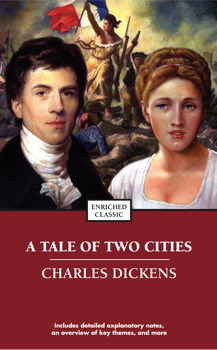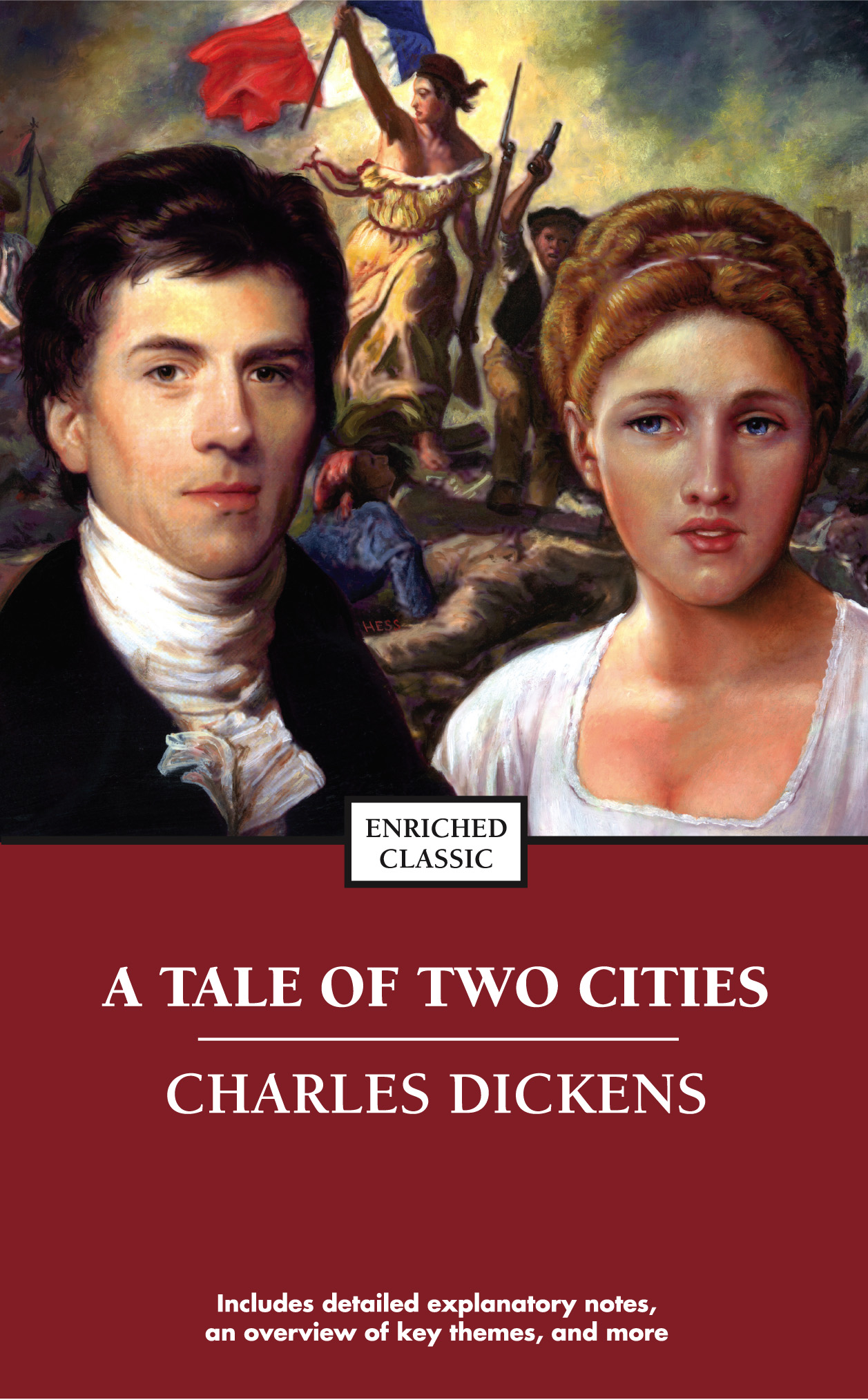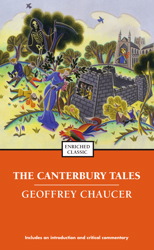LIST PRICE $7.99
PRICE MAY VARY BY RETAILER
Free shipping when you spend $40. Terms apply.
Buy from Other Retailers
Table of Contents
About The Book
Enriched Classics offer readers accessible editions of great works of literature enhanced by helpful notes and commentary. Each book includes educational tools alongside the text, enabling students and readers alike to gain a deeper and more developed understanding of the writer and their work.
Dickens's epic novel of freedom, love, and the burning chaos of the French Revolution.
This edition includes:
-A concise introduction that gives readers important background information
-A chronology of the author's life and work
-A timeline of significant events that provides the book's historical context
-An outline of key themes and plot points to help readers form their own interpretations
-Detailed explanatory notes
-Critical analysis, including contemporary and modern perspectives on the work
-Discussion questions to promote lively classroom and book group interaction
-A list of recommended related books and films to broaden the reader's experience
Enriched Classics offer readers affordable editions of great works of literature enhanced by helpful notes and insightful commentary. The scholarship provided in Enriched Classics enables readers to appreciate, understand, and enjoy the world's finest books to their full potential.
Dickens's epic novel of freedom, love, and the burning chaos of the French Revolution.
This edition includes:
-A concise introduction that gives readers important background information
-A chronology of the author's life and work
-A timeline of significant events that provides the book's historical context
-An outline of key themes and plot points to help readers form their own interpretations
-Detailed explanatory notes
-Critical analysis, including contemporary and modern perspectives on the work
-Discussion questions to promote lively classroom and book group interaction
-A list of recommended related books and films to broaden the reader's experience
Enriched Classics offer readers affordable editions of great works of literature enhanced by helpful notes and insightful commentary. The scholarship provided in Enriched Classics enables readers to appreciate, understand, and enjoy the world's finest books to their full potential.
Reading Group Guide
This reading group guide for An Atlas of Impossible Longing includes an introduction, discussion questions, and ideas for enhancing your book club. The suggested questions are intended to help your reading group find new and interesting angles and topics for your discussion. We hope that these ideas will enrich your conversation and increase your enjoyment of the book.
INTRODUCTION
In this reimagining of Charles Dickens’s classic, Great Expectations, Pip is an orphaned young werewolf living with his ill-tempered sister and her gentle husband, the blacksmith Joe Gargery. One fateful night, visiting his parents’ grave under the full moon, Pip encounters a frightening stranger—another werewolf and a convict no less. Too afraid to do anything other than obey the stranger’s instruction, Pip helps this convict and sets in motion of chain of events that will forever change the course of his life. Pip is sent to reside with Miss Havisham, a vampire who was sired and left on her wedding day by the one she loved. She has adopted Estella and raised her as a vampire slayer, to seek revenge on the supernatural creatures that she blames for her ruin. Pip, in awe of Estella’s beauty, falls instantly in love with her despite the fact that she has been trained to hate all “Scapegraces.” When an anonymous benefactor sends Pip to London to become a gentleman, he believes it is his chance to win Estella’s hand. The question that lies ahead is whether Pip will be able to overcome his wolfish ways and turn his once grave expectations for himself into great ones.
TOPICS AND QUESTIONS FOR DISCUSSION
1. In Pip’s world, the term “Scapegraces” is used to define “those of a supernatural sort” (p. 11). What do you think this term implies about the way that creatures like werewolves and vampires were viewed in this society?
2. On page 12, Pip wonders, “Was it a crime to merely be different?” While being a werewolf is simply a condition inherited at birth, vampires prey on the living to increase their population, and yet are “considered civilized and welcome to mix in society.” Is one creature more monstrous than the other? Do both werewolves and vampires have the capacity for good and evil?
3. After being invited to Miss Havisham’s and then later learning of his anonymous benefactor, Pip often feels ashamed of his roots, and of Joe’s commonness even more so than his own Scapegrace status. Yet Joe never seems to exhibit any embarrassment over Pip’s wolfishness. What does this say about each of their characters? What influences the focus of Pip’s shame?
4. When Mrs. Joe dies (the first time), Pip finds what he knows to be evidence of Magwitch’s crime, but he still does not accuse him. Why do you think Pip believes that Magwitch is innocent of this crime when the main piece of evidence points directly to him?
5. Throughout most of the story, Estella is cold-hearted and shows no affection for Pip despite his unwavering love for her. Why should he love someone who could possibly end up killing him in her crusade against Scapegraces? What makes him fall in love with her in the first place? Why do you think Pip continues to pursue someone who will never return his feelings?
6. Pip and Herbert have a very special friendship. Do you think this brotherly love grew out of the wolfish need to be part of a pack? Or something more human?
7. While Miss Havisham is herself a vampire, she has trained Estella in the ways of vampire slaying. Pip wonders “if Miss Havisham weren’t really wishing to be staked by Estella one day in raising her to such an art” (p. 235). Do you agree? Do you think Miss Havisham’s eventual outcome either supports or refutes this opinion? Why does Estella never stake her, if indeed her mission is to kill vampires?
8. Pip is horrified when he finds out the Magwitch has been his anonymous benefactor all along. Why do you think this revelation is so abhorrent to Pip, when he seems so willing to not only protect Magwitch and keep him safe, but to also protect his feelings by not revealing his disappointment?
9. On page 284, Pip explains to Miss Havisham that there are certain Scapegraces who “showed more humanity than the humans.” Discuss which of the Scapegraces behave with the utmost humanity, and which of the human characters exhibit what could be categorized as monstrous behavior?
10. How does the discovery of Estella’s parentage change things for Pip? Does it change your opinion of her?
11. Why is it so easy for Joe and Biddy to forgive Pip after he had neglected them for so many years? Should Joe have been angry that Pip spent so much time visiting Magwitch after he was captured, when he never kept up his visits to Joe like he had promised?
12. Though Estella is able to eventually see the goodness in werewolves, she never changes her opinion of vampires. Why do you think she can pardon and accept most Scapegraces and still seek vengeance against vampires?
ENHANCE YOUR BOOK CLUB
1. Grave Expectations is a reimagining of Charles Dickens’s classic Great Expectations. Have you read Great Expectations before? If so, how did the supernatural version compare to the classic? What remained the same in this new version of the story? What changed? If not, choose Great Expectations for your next book club pick.
2. Grave Expectations is a literary mash-up—where a fictional classic is retold in present day or with mythical substitutions. Examples include Pride and Prejudice and Zombies or the movie Clueless, which was essentially Jane Austen’s Emma set in Beverly Hills during the 1990s. Try creating a literary mash-up of your own with your book club. Pick a favorite classic and retell the story as though it took place in the present day or with some supernatural characters. The more imaginative, the better!
3. Legends of werewolves and vampires have been carried down through the centuries. How does their depiction in this work compare with your preconceived notions of such supernatural creatures?
INTRODUCTION
In this reimagining of Charles Dickens’s classic, Great Expectations, Pip is an orphaned young werewolf living with his ill-tempered sister and her gentle husband, the blacksmith Joe Gargery. One fateful night, visiting his parents’ grave under the full moon, Pip encounters a frightening stranger—another werewolf and a convict no less. Too afraid to do anything other than obey the stranger’s instruction, Pip helps this convict and sets in motion of chain of events that will forever change the course of his life. Pip is sent to reside with Miss Havisham, a vampire who was sired and left on her wedding day by the one she loved. She has adopted Estella and raised her as a vampire slayer, to seek revenge on the supernatural creatures that she blames for her ruin. Pip, in awe of Estella’s beauty, falls instantly in love with her despite the fact that she has been trained to hate all “Scapegraces.” When an anonymous benefactor sends Pip to London to become a gentleman, he believes it is his chance to win Estella’s hand. The question that lies ahead is whether Pip will be able to overcome his wolfish ways and turn his once grave expectations for himself into great ones.
TOPICS AND QUESTIONS FOR DISCUSSION
1. In Pip’s world, the term “Scapegraces” is used to define “those of a supernatural sort” (p. 11). What do you think this term implies about the way that creatures like werewolves and vampires were viewed in this society?
2. On page 12, Pip wonders, “Was it a crime to merely be different?” While being a werewolf is simply a condition inherited at birth, vampires prey on the living to increase their population, and yet are “considered civilized and welcome to mix in society.” Is one creature more monstrous than the other? Do both werewolves and vampires have the capacity for good and evil?
3. After being invited to Miss Havisham’s and then later learning of his anonymous benefactor, Pip often feels ashamed of his roots, and of Joe’s commonness even more so than his own Scapegrace status. Yet Joe never seems to exhibit any embarrassment over Pip’s wolfishness. What does this say about each of their characters? What influences the focus of Pip’s shame?
4. When Mrs. Joe dies (the first time), Pip finds what he knows to be evidence of Magwitch’s crime, but he still does not accuse him. Why do you think Pip believes that Magwitch is innocent of this crime when the main piece of evidence points directly to him?
5. Throughout most of the story, Estella is cold-hearted and shows no affection for Pip despite his unwavering love for her. Why should he love someone who could possibly end up killing him in her crusade against Scapegraces? What makes him fall in love with her in the first place? Why do you think Pip continues to pursue someone who will never return his feelings?
6. Pip and Herbert have a very special friendship. Do you think this brotherly love grew out of the wolfish need to be part of a pack? Or something more human?
7. While Miss Havisham is herself a vampire, she has trained Estella in the ways of vampire slaying. Pip wonders “if Miss Havisham weren’t really wishing to be staked by Estella one day in raising her to such an art” (p. 235). Do you agree? Do you think Miss Havisham’s eventual outcome either supports or refutes this opinion? Why does Estella never stake her, if indeed her mission is to kill vampires?
8. Pip is horrified when he finds out the Magwitch has been his anonymous benefactor all along. Why do you think this revelation is so abhorrent to Pip, when he seems so willing to not only protect Magwitch and keep him safe, but to also protect his feelings by not revealing his disappointment?
9. On page 284, Pip explains to Miss Havisham that there are certain Scapegraces who “showed more humanity than the humans.” Discuss which of the Scapegraces behave with the utmost humanity, and which of the human characters exhibit what could be categorized as monstrous behavior?
10. How does the discovery of Estella’s parentage change things for Pip? Does it change your opinion of her?
11. Why is it so easy for Joe and Biddy to forgive Pip after he had neglected them for so many years? Should Joe have been angry that Pip spent so much time visiting Magwitch after he was captured, when he never kept up his visits to Joe like he had promised?
12. Though Estella is able to eventually see the goodness in werewolves, she never changes her opinion of vampires. Why do you think she can pardon and accept most Scapegraces and still seek vengeance against vampires?
ENHANCE YOUR BOOK CLUB
1. Grave Expectations is a reimagining of Charles Dickens’s classic Great Expectations. Have you read Great Expectations before? If so, how did the supernatural version compare to the classic? What remained the same in this new version of the story? What changed? If not, choose Great Expectations for your next book club pick.
2. Grave Expectations is a literary mash-up—where a fictional classic is retold in present day or with mythical substitutions. Examples include Pride and Prejudice and Zombies or the movie Clueless, which was essentially Jane Austen’s Emma set in Beverly Hills during the 1990s. Try creating a literary mash-up of your own with your book club. Pick a favorite classic and retell the story as though it took place in the present day or with some supernatural characters. The more imaginative, the better!
3. Legends of werewolves and vampires have been carried down through the centuries. How does their depiction in this work compare with your preconceived notions of such supernatural creatures?
Product Details
- Publisher: Simon & Schuster (May 1, 2004)
- Length: 496 pages
- ISBN13: 9780743487603
Resources and Downloads
High Resolution Images
- Book Cover Image (jpg): A Tale of Two Cities Enriched Classic Mass Market Paperback 9780743487603(0.6 MB)





















